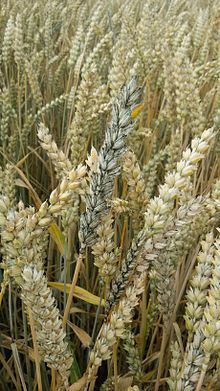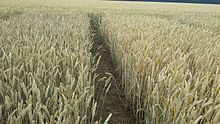Blackness mushrooms
The black fungi (Dematiaceae) are a form family within the Fungi imperfecti . Since the classification is a so-called form taxon , the genera it contains are not naturally related to one another, but are only similar in their biology and morphology.
All black fungi are primarily saprophytes that feed on dead organic matter. They do not undergo sexual reproduction and have dark-colored conidia due to melanin . The resulting mostly blackish mushroom lawn gave the Form family its name.
Many blackening fungi are found as mold in apartments. In agriculture, they colonize mature plants or occur as pathogens . Whole crops turn gray in cereal cultivation, especially in wet years with delayed harvest, and the quality of the harvest can be reduced ( mycotoxins ).
Genera
There are numerous genera in the Dematiaceae (black fungus) family of forms. Since the classification was made primarily on the basis of the biology and morphology of the fungi, it can change depending on the level of knowledge, e.g. B. if a sexual form of reproduction is found in a genus (the taxonomic classification of mushrooms is based primarily on their sexual form).
Important representatives include:
1) In the meantime, sexual forms have been proven for some genera. They are therefore officially assigned to other families. Their further mention in the family of black fungi has traditional reasons or is based on the fact that their sexual form was previously only detectable under laboratory conditions.
Harmful effect
All genera and species of black fungi colonize dead plant parts as destructors (saprophytes). But they can also decompose building materials and food and thus damage people as molds.
In plants, some of them also appear as pathogens. This includes some important plant diseases such as
- Spray spot disease of potatoes (Alternaria disease)
- Leaf drought on maize ( Helminthosporium )
- Pear black spot disease ( Stemphylium vesicarium )
- Sugar beet leaf spot disease ( Cercospora beticola )
Black fungi in cereal cultivation
Many species and genera of black fungi colonize cereals such as wheat, rye and barley. They are not capable of actively infecting living parts of plants, but all cereals die in the course of their natural ripening. The mushrooms feed on the dead straw and the starch and nutrient-filled grains in the ears. Under normal growth and harvest conditions, this colonization is of no consequence. The fungi only appear later as decomposers of the harvest residues in the soil. There they are an important part of the nutrient cycle.
In wet years, when the growing conditions for the mushrooms are good and the harvest is delayed by weeks in some cases because of the wetness, there can be an explosive multiplication. Areas with storage are particularly affected. In this case, the entire stock turns grayish due to the formation of the dark mold lawn from mycelium and conidia carriers. The intensity of the black color increases the longer the fungi grow on the plants. The loss of yield (quantitative damage) is usually hardly detectable as the fungi only appear after the grain has been filled. However, some species can form mycotoxins, which is why the quality of the harvest deteriorates with increasing blackness.
The blackness infestation is essentially contained by a healthy grain stock and a timely harvest. In years with high infestation pressure, ears can also be treated with fungicides .

